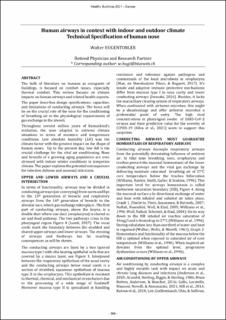| dc.contributor.author | Hugentobler, Walter | |
| dc.date.accessioned | 2022-01-31T15:18:55Z | |
| dc.date.available | 2022-01-31T15:18:55Z | |
| dc.date.issued | 2021 | |
| dc.identifier.isbn | 978-82-536-1728-2 | |
| dc.identifier.issn | 2387-4295 | |
| dc.identifier.uri | https://hdl.handle.net/11250/2976096 | |
| dc.description.abstract | The bulk of literature on humans as occupants of buildings, is focused on comfort issues, especially thermal comfort. This review focuses on climate impacts on human airways and related health aspects. The paper describes design specifications, capacities, and limitations of conducting airways. The focus will be on the crucial role of the nose for the conditioning of breathing air to the physiological requirements of gas exchange in the alveoli. Throughout several million years of humankind’s evolution, the nose adapted to extreme climate situations in terms of moisture and temperature conditions. Low absolute humidity (AH) was the climate factor with the greatest impact on the shape of human noses. Up to the present day, low AH is the crucial challenge for the vital air conditioning. Nose and bronchi of a growing aging population are over stressed with indoor winter conditions in temperate climate. The paper explains the potential consequences for infection defense and seasonal infections. | |
| dc.language.iso | eng | |
| dc.publisher | SINTEF Academic Press | |
| dc.relation.ispartof | Healthy Buildings 2021 – Europe. Proceedings of the 17th International Healthy Buildings Conference 21–23 June 2021 | |
| dc.relation.ispartofseries | SINTEF Proceedings;9 | |
| dc.rights | CC BY 4.0 | |
| dc.rights.uri | https://creativecommons.org/licenses/by/4.0/ | |
| dc.title | Human airways in context with indoor and outdoor climate Technical Specification of human nose | |
| dc.type | Chapter | |
| dc.type | Peer reviewed | |
| dc.type | Conference object | |
| dc.description.version | publishedVersion | |
| dc.rights.holder | © 2021 The Authors. Published by SINTEF Academic Press. | |
| dc.subject.nsi | VDP::Teknologi: 500 | |

